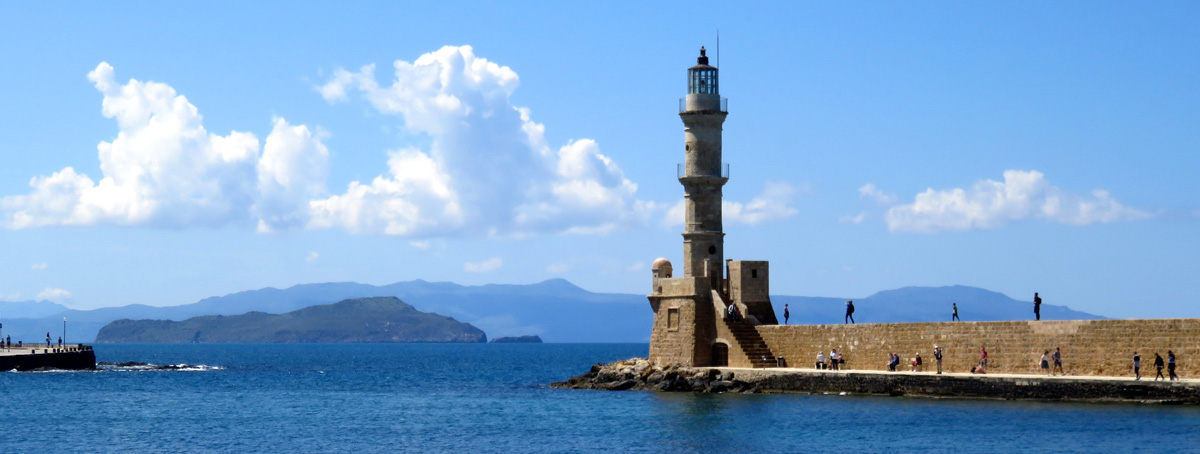
7000 – 1100 BC
Crete was inhabited from 7000 BC and possibly even before that. Its inhabitants were Pelasgens who came from Pelopónnisos. The Neolithic civilisation that developed there was wiped out around 3000 BC and a unique civilisation evolved (2800 – 1100 BC) now known as Minoan (it was so characterised by Evans, the English archaeologist responsible for the excavations at KNOSSÓS, after Mínos the mythical King of Crete (2 Kings named Mínos have been reported, whilst some archaeologists believe that “Mínos” was a title, like Pharaoh, Caesar or Kaiser). According to mythology, Mínos was the son of Zeus and Europe). Archaeologists divide the Minoan period into three phases:
Early-Minoan period (2800 – 2100 BC): During this period villages were built and coastal towns were founded in the eastern part of Crete. Vases, weapons and tools were manufactured and commerce developed throughout the Mediterranean, reaching as far as England (Minoan vases of the period have been found in England) and the Baltic Sea.
Mid-Minoan period (2100 – 1600 BC): Large cities were founded, palaces erected, penmanship was invented or adopted from mainland Greece, arts were developed (decorated vases, magnificent frescoes, ceramic vases with walls as thin as egg-shells, from which sprung the English term egg-shell ware, and others), outside commerce was developed as well as political relationships (an Egyptian ambassador was a permanent resident of Mínos’ court). During this period the island was twice shook violently by terrifying earthquakes, around 1900 and 1600 BC – evidently from the explosion of Santoríni’s volcano – leaving Knossós partially destroyed and the whole of the eastern basilica flattened.
Later-Minoan period (1600 – 1100 BC): The initial phase of this period saw the acme of the civilisation and political force of Minoan Crete. The island became a united state with KNOSSÓS as its capital. The Mínos King-prelate governed for nine years and would go after his term of office to the terrifying cave of the Minotaur, where he would then give an account of his state during the nine years of his rule to Zeus. If Zeus was satisfied, then Mínos would climb down the mountain and continue to rule for another nine years. If not, then he would disappear. As he came down with renewed divine orders, Mínos would bring with him, like Moses, sacred laws and decrees. The philosopher Pláton informs that those laws were also applied in mainland Greece, as they were solidly based upon logic and equality. The Minoan Prime Minister, Tálos, visited every region of the state three times a year, in order to check the judicial authorities and the execution of the laws. Apart from inner development (roads, bridges, buildings, arts etc.), Crete also expanded with its colonies. It colonised much of the Cyclades, many areas of mainland Greece, as well as parts of Sicily, Syria, Libya, Arabia and elsewhere. These colonies were commercial stations, the majority of which were founded by the Cretans and not taken by force. During this period Mínos captured Athens and placed upon the city the heavy tax of sending it’s young to be prey to the Minotaur (see below, note “Soúnio”). Crete’s fleet protected its colonies. Indeed Crete was experiencing a pinnacle of civilisation and national power, when Achaeans from Attikí, brought about the collapse of the Minoan state in around 1400 BC (this is reminiscent of the myth of Theséus, who killed the Minotaur). The foray occurred after the assassination of Mínos and the overwhelming of the whole Minoan fleet by the rough seas around Sicily, where a campaign had taken place to punish Daídalos (Daedalus – Athenian architect, who made the labyrinth). The Minoan empire was never able to recover from such a disaster.

Chaniá: Built on the site of ancient Kydonía, it has been continually inhabited since the Neolithic age. During the 7th century AD it was destroyed but was rebuilt by the Venetians in the 13th century. It is separated into the old and new town. The old town is built around the Venetian harbour where the Fort of Firkás dominates over the NW coast (the Greek Flag was first raised here in 1913 and saw the island liberated) whilst on the E part of its entrance stands the Venetian light. The harbour is remarkable and is a main attraction for all visitors. For excursions into the town visit the quarters of “Koúm-Kapí” (among the most well-known), “Chalépa” (historic, among the most beautiful, the house where the leader of the Greek Nation Elefthérios Venizélos lived stands here), “Splántzia” (with a Turkish minaret) and “Topanás” (with Venetian buildings). Also visit the Public Market to shop. It has many nice wares. Along the length of the northern side there are shops with leather goods and traditional Cretan boots (stivánia).
Gávdos is idendified as Ogygía, the island of Calypsó, who kept Odysseus captive for 6 years. The island has been inhabited since prehistoric years. The “daughter of Gávdos”, female statue dating from the Roman era, can now be seen in the British Musuem. The island has beautiful beaches and wonderful clear water.




